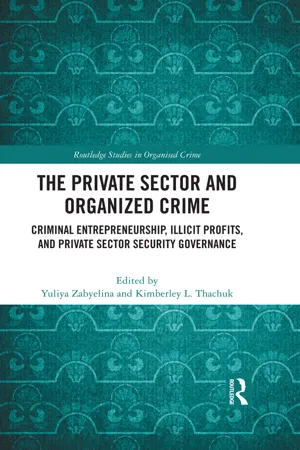
The Private Sector and Organized Crime
Criminal Entrepreneurship, Illicit Profits, and Private Sector Security Governance
- 344 pages
- English
- ePUB (mobile friendly)
- Available on iOS & Android
The Private Sector and Organized Crime
Criminal Entrepreneurship, Illicit Profits, and Private Sector Security Governance
About this book
This book contributes to the literature on organized crime by providing a detailed account of the various nuances of what happens when criminal organizations misuse or penetrate legitimate businesses. It advances the existing scholarship on attacks, infiltration, and capture of legal businesses by organized crime and sheds light on the important role the private sector can play to fight back. It considers a range of industries from bars and restaurants to labour-intensive enterprises such as construction and waste management, to sectors susceptible to illicit activities including transportation, wholesale and retail trade, and businesses controlled by fragmented legislation such as gambling.
Organized criminal groups capitalize on legitimate businesses beleaguered by economic downturns, government regulations, natural disasters, societal conflict, and the COVID-19 pandemic. To survive, some private companies have even become the willing partners of criminal organizations. Thus, the relationships between licit businesses and organized crime are highly varied and can range from victimization of businesses to willing collusion and even exploitation of organized crime by the private sector – albeit with arrangements that typically allow plausible deniability. In other words, these relationships are highly diverse and create a complex reality which is the focus of the articles presented here.
This book will appeal to students, academics, and policy practitioners with an interest in organized crime. It will also provide important supplementary reading for undergraduate and graduate courses on topics such as transnational security issues, transnational organized crime, international criminal justice, criminal finance, non-state actors, international affairs, comparative politics, and economics and business courses.
Frequently asked questions
- Essential is ideal for learners and professionals who enjoy exploring a wide range of subjects. Access the Essential Library with 800,000+ trusted titles and best-sellers across business, personal growth, and the humanities. Includes unlimited reading time and Standard Read Aloud voice.
- Complete: Perfect for advanced learners and researchers needing full, unrestricted access. Unlock 1.4M+ books across hundreds of subjects, including academic and specialized titles. The Complete Plan also includes advanced features like Premium Read Aloud and Research Assistant.
Please note we cannot support devices running on iOS 13 and Android 7 or earlier. Learn more about using the app.
Information
Table of contents
- Cover
- Endorsements Page
- Half-Title Page
- Series Page
- Title Page
- Copyright Page
- Dedication
- Contents
- Notes on Contributors
- Foreword
- List of Acronyms
- Acknowledgments
- Introduction
- Chapter 1 Theorizing the Linkages between the Private Sector and Organized Crime
- Chapter 2 A Review of Methods in Research on Organized Crime Infiltration of Legitimate Businesses
- Chapter 3 Organized Crime and the Haulage Sector
- Chapter 4 Private Port Authorities and Organized Crime
- Chapter 5 Information Technology and Communications Providers’ Measures against Organized Crime
- Chapter 6 Organized Crime and the Hydrocarbons Industry
- Chapter 7 Trafficking in Persons and the Hotel Industry
- Chapter 8 Organized Crime in the Waste Management Industry
- Chapter 9 Organized Crime in the Fisheries Sector
- Chapter 10 Organized Forest Crimes: Charcoal and Timber Trade in the Democratic Republic of the Congo
- Chapter 11 Organized Crime in the Agri-Food Industry
- Chapter 12 Organized Crime and the Retail Sector
- Chapter 13 Organized Crime Money Laundering through Online Gambling Businesses in Great Britain
- Chapter 14 Private Art Businesses and Organized Crime
- Chapter 15 Organized Crime and the Pharmaceutical Industry
- Chapter 16 Organized Crime Links to Tobacco Companies
- Chapter 17 Organized Crime and the Private Security Industry
- Chapter 18 Private Sector Criminal Risk Assessment and Risk Management
- Index